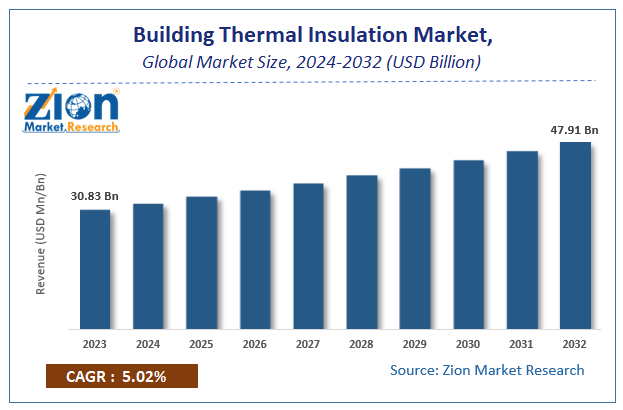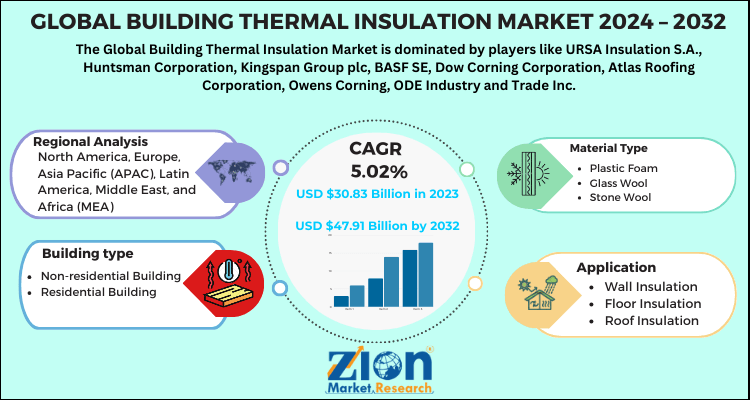Building Thermal Insulation Market Size, Share, Analysis, Trends, Growth, Forecasts, 2032

Building Thermal Insulation Market - By Building Type (Non-Residential Building And Residential Building), By Material Type (Plastic Foam, Glass Wool, And Stone Wool), By Application (Wall Insulation, Floor Insulation, And Roof Insulation), And By Region - Global Industry Perspective, Comprehensive Analysis, And Forecast, 2024 - 2032
| Market Size in 2023 | Market Forecast in 2032 | CAGR (in %) | Base Year |
|---|---|---|---|
| USD 30.83 Billion | USD 47.91 Billion | 5.02% | 2023 |
Building Thermal Insulation Industry Prospective
Zion Market Research has published a report on the global Building Thermal Insulation Market, estimating its value at USD 30.83 Billion in 2023, with projections indicating that it will reach USD 47.91 Billion by 2032. The market is expected to expand at a compound annual growth rate (CAGR) of 5.02% over the forecast period 2024-2032. The report explores the factors fueling market growth, the hitches that could hamper this expansion, and the opportunities that may arise in the Building Thermal Insulation industry. Additionally, it offers a detailed analysis of how these elements will affect market demand dynamics and market performance throughout the forecast period.
Building Thermal Insulation Market: Overview
The Building Thermal Insulation Market focuses on the production and application of materials that reduce heat transfer in buildings, improving energy efficiency and occupant comfort. Thermal insulation is widely used in residential, commercial, and industrial structures to minimize heating and cooling demands, thereby reducing energy consumption and greenhouse gas emissions. The market is driven by stringent building codes, increasing awareness of energy efficiency, and growing demand for sustainable construction materials. With advancements in insulation technologies and rising urbanization, particularly in emerging economies, the market is expected to grow significantly, supported by government incentives promoting energy-efficient buildings.
Thermal insulation is one of the known phenomenon in construction activities and is utilized for transferring heat among the adjacent environments. It plays a major part in retaining ambient climatic conditions indoors without using additional energy. In the recent times, thermal insulation is utilized in buildings for reducing the carbon footprints and restricting the thermal conduction to external environment.
Building Thermal Insulation Market: Growth Factors
The Building Thermal Insulation Market is witnessing robust growth due to several key factors, including increasing awareness of energy efficiency, regulatory frameworks, and advancements in sustainable construction practices. Here are the primary growth factors driving the market:
-
Growing Focus on Energy Efficiency: As energy costs rise and environmental concerns become more pressing, there is a strong demand for building thermal insulation to reduce energy consumption. Insulated buildings can significantly lower heating and cooling needs, reducing utility costs and greenhouse gas emissions, which appeals to both consumers and governments.
-
Stringent Building Codes and Regulations: Governments worldwide are implementing stricter building codes and regulations to promote energy-efficient construction. These regulations often mandate the use of insulation materials in new constructions and renovations, boosting demand in the building thermal insulation market.
-
Increasing Demand for Sustainable Construction Materials: With the rise of green building certifications like LEED and BREEAM, the use of eco-friendly insulation materials, such as recycled and natural fiber insulations, is growing. This shift towards sustainable materials is driving innovation and market expansion, particularly in environmentally conscious regions.
-
Urbanization and Infrastructure Development: Rapid urbanization in emerging economies is fueling the demand for residential and commercial buildings, which in turn is increasing the need for thermal insulation solutions. Infrastructure development projects in Asia-Pacific, the Middle East, and Latin America are key contributors to the market's growth.
-
Advancements in Insulation Technologies: Continuous technological innovations in insulation materials, such as improved thermal resistance, fire safety, and soundproofing properties, are enhancing the appeal of thermal insulation products. These advancements allow for more efficient energy performance in buildings, driving market demand.
-
Government Incentives and Subsidies: Many governments are offering financial incentives, such as tax rebates and subsidies, to encourage homeowners and businesses to install thermal insulation. These programs, aimed at reducing energy consumption, are contributing to the market’s growth by making insulation solutions more affordable and accessible.
-
Rising Awareness of Climate Change: Increasing public awareness of climate change and the importance of reducing carbon footprints has led to a growing preference for energy-efficient homes and buildings. This trend is boosting the adoption of thermal insulation materials as part of broader energy-saving strategies.
Overall, the combination of regulatory support, technological advancements, urban growth, and environmental awareness is propelling the growth of the building thermal insulation market globally.
Building Thermal Insulation Market: Segmentation
The global building thermal insulation market report divides the market into multiple segments on the basis of building type, material type, applications, and geography.
Based on the building type, the market is segmented into non-residential buildings and residential buildings.
By material type, the market is categorized into plastic foam, glass wool, and stone wool.
By application, the global market is bifurcated into wall insulation, floor insulation, and roof insulation.
Beneficial laws due to growing focus on reducing the total power usage will steer the expansion of building thermal insulation industry over the estimated timespan. Thermal insulation assists in minimizing the dependence on heat, ventilation, and air conditioning and thus lowers the total power usage, thereby prompting the growth of building thermal insulation market. Escalating demand for the product across residential as well as commercial sectors in emerging nations is speculated to enlarge the scope of the market over the forecasting years.
Building Thermal Insulation Market: Report Scope
| Report Attributes | Report Details |
|---|---|
| Report Name | Building Thermal Insulation Market |
| Market Size in 2023 | USD 30.83 Billion |
| Market Forecast in 2032 | USD 47.91 Billion |
| Growth Rate | CAGR of 5.02% |
| Number of Pages | 110 |
| Key Companies Covered | URSA Insulation S.A., Huntsman Corporation, Kingspan Group plc, BASF SE, Dow Corning Corporation, Atlas Roofing Corporation, Owens Corning, ODE Industry and Trade Inc., Beijing New Building Material (Group) Co. Ltd., Paroc Group Oy, Trocellen GmbH, Knauf Insulation, Inc., Cabot Corporation, GAF Materials Corporation, Firestone Building Products Company, Lapolla Industries Inc., KCC Corporation, Saint-Gobain S.A., Rockwool International A/S, Covestro AG, Fletcher Building Limited, Recticel SA, NICHIAS Corporation, Johns Manville Corporation, and Aspen Aerogels, Inc |
| Segments Covered | By Building Type, By Material Type, By Application And By Region |
| Regions Covered | North America, Europe, Asia Pacific (APAC), Latin America, Middle East, and Africa (MEA) |
| Base Year | 2023 |
| Historical Year | 2018 to 2022 |
| Forecast Year | 2024 - 2032 |
| Customization Scope | Avail customized purchase options to meet your exact research needs. Request For Customization |
Furthermore, the emerging economies including Brazil, China, and India is anticipated to embellish the expansion of building thermal insulation industry over the forecast timespan. Large-scale need for green constructions across the globe is anticipated to steer the expansion of building thermal insulation industry over the forecast timeframe. End-users are highlighting on minimizing power consumption bills and are focusing on renovation. This will further accentuate the expansion of building thermal insulation industry over the coming decade. Apparently, the rise in the public-private associations for constructing new residences along with the stringent implementation of building codes for minimizing power consumption in factories will elevate the expansion of the market size in the years ahead.
Building Thermal Insulation Market: Regional Insights
North America To Account For Major Market Share Over 2024–2032
The growth of the market in North America over the forecast timespan is due to presence of large number of end-users in the countries like the U.S. and Canada. In addition to this, strict execution of government rules pertaining to house insulation will crop up the growth of the market in the forthcoming years.
Building Thermal Insulation Market: Competitive Space
Key players included in the report are
- URSA Insulation S.A.
- Huntsman Corporation
- Kingspan Group plc
- BASF SE
- Dow Corning Corporation
- Atlas Roofing Corporation
- Owens Corning
- ODE Industry and Trade Inc.
- Beijing New Building Material (Group) Co. Ltd.
- Paroc Group Oy
- Trocellen GmbH
- Knauf Insulation. Inc.
- Cabot Corporation
- GAF Materials Corporation
- Firestone Building Products Company
- Lapolla Industries Inc.
- KCC Corporation
- Saint-Gobain S.A.
- Rockwool International A/S
- Covestro AG
- Fletcher Building Limited
- Recticel SA
- NICHIAS Corporation
- Johns Manville Corporation
- Aspen Aerogels. Inc.
The market report categorizes the global building thermal insulation market based on:
Building type:
- Non-residential Building
- Residential Building
Material Type:
- Plastic Foam
- Glass Wool
- Stone Wool
Application:
- Wall Insulation
- Floor Insulation
- Roof Insulation
By Region
- North America
- The U.S.
- Canada
- Europe
- France
- The UK
- Spain
- Germany
- Italy
- Rest of Europe
- Asia Pacific
- China
- Japan
- India
- South Korea
- Southeast Asia
- Rest of Asia Pacific
- Latin America
- Brazil
- Mexico
- Rest of Latin America
- Middle East & Africa
- GCC
- South Africa
- Rest of Middle East & Africa
Table Of Content
Methodology
FrequentlyAsked Questions
Beneficial laws due to growing focus on reducing the total power usage will steer the expansion of building thermal insulation industry over the estimated timespan.
The CAGR of the industry is expected to be nearly 4.95% during the forecast timeline.
North America will contribute remarkably towards the global market share over the estimated timeline.
The key market players include Huntsman Corporation, BASF SE, Dow Corning Corporation, Atlas Roofing Corporation, Owens Corning, Beijing New Building Material (Group) Co. Ltd., Trocellen GmbH, Knauf Insulation, Inc, Firestone Building Products Company, URSA Insulation S.A., Lapolla Industries Inc., ODE Industry and Trade Inc., KCC Corporation, Saint-Gobain S.A., Rockwool International A/S, Covestro AG, GAF Materials Corporation, Fletcher Building Limited, Recticel SA, NICHIAS Corporation, Cabot Corporation, Johns Manville Corporation, Paroc Group Oy, Kingspan Group plc, and Aspen Aerogels, Inc.
RelatedNews
HappyClients
Zion Market Research
Tel: +1 (302) 444-0166
USA/Canada Toll Free No.+1 (855) 465-4651
3rd Floor,
Mrunal Paradise, Opp Maharaja Hotel,
Pimple Gurav, Pune 411061,
Maharashtra, India
Phone No +91 7768 006 007, +91 7768 006 008
US OFFICE NO +1 (302) 444-0166
US/CAN TOLL FREE +1 (855) 465-4651
Email: sales@zionmarketresearch.com
We have secured system to process your transaction.
Our support available to help you 24 hours a day, five days a week.
Monday - Friday: 9AM - 6PM
Saturday - Sunday: Closed







